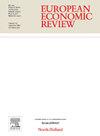Density forecasts of inflation: A quantile regression forest approach
IF 2.8
2区 经济学
Q1 ECONOMICS
引用次数: 0
Abstract
Inflation density forecasts are a fundamental input for a medium-term-oriented central bank, such as the European Central Bank (ECB). We demonstrate that a quantile regression forest, which captures general non-linear relationships between euro area inflation (both headline and core) and a broad set of determinants, performs competitively against state-of-the-art linear and non-linear benchmarks and judgmental forecasts. The median forecasts generated by the quantile regression forest exhibit a high degree of collinearity with the Eurosystem inflation point forecasts, displaying similar deviations from “linearity”. Given that the Eurosystem’s modeling toolbox predominantly relies on linear frameworks, this finding suggests that the expert judgment embedded in the projections may incorporate mild non-linear elements. Finally, we provide a real-time application illustrating how the model is employed to assess risks surrounding the Eurosystem inflation projections in the context of the recent euro area disinflation path.
通货膨胀的密度预测:分位数回归森林方法
通胀密度预测是欧洲央行(ECB)等以中期为导向的中央银行的基本输入。我们证明了一个分位数回归森林,它捕获了欧元区通胀(包括总体通胀和核心通胀)与一系列决定因素之间的一般非线性关系,与最先进的线性和非线性基准和判断预测相比,具有竞争力。分位数回归森林生成的中位数预测与欧元体系通胀点预测表现出高度共线性,显示出类似的“线性”偏差。鉴于欧元体系的建模工具箱主要依赖于线性框架,这一发现表明,嵌入预测中的专家判断可能包含轻微的非线性元素。最后,我们提供了一个实时应用程序,说明该模型如何在最近欧元区反通胀路径的背景下评估围绕欧元体系通胀预测的风险。
本文章由计算机程序翻译,如有差异,请以英文原文为准。
求助全文
约1分钟内获得全文
求助全文
来源期刊

European Economic Review
ECONOMICS-
CiteScore
4.70
自引率
3.60%
发文量
170
期刊介绍:
The European Economic Review (EER) started publishing in 1969 as the first research journal specifically aiming to contribute to the development and application of economics as a science in Europe. As a broad-based professional and international journal, the EER welcomes submissions of applied and theoretical research papers in all fields of economics. The aim of the EER is to contribute to the development of the science of economics and its applications, as well as to improve communication between academic researchers, teachers and policy makers across the European continent and beyond.
 求助内容:
求助内容: 应助结果提醒方式:
应助结果提醒方式:


